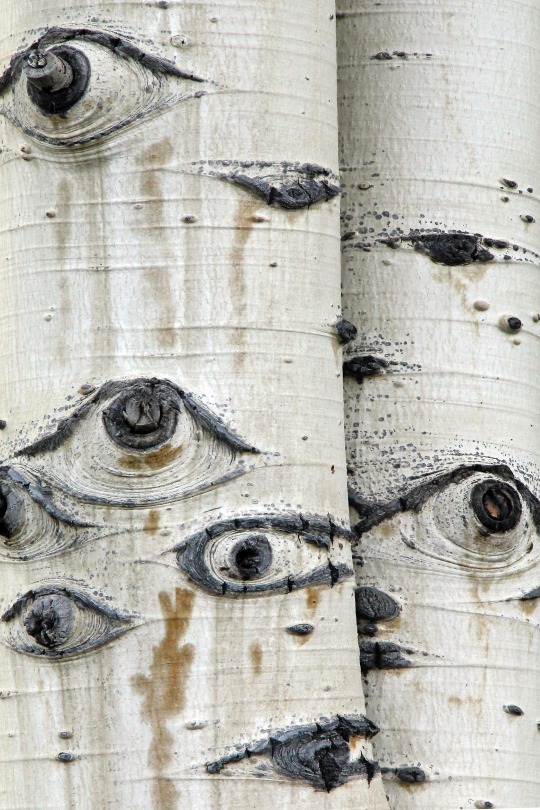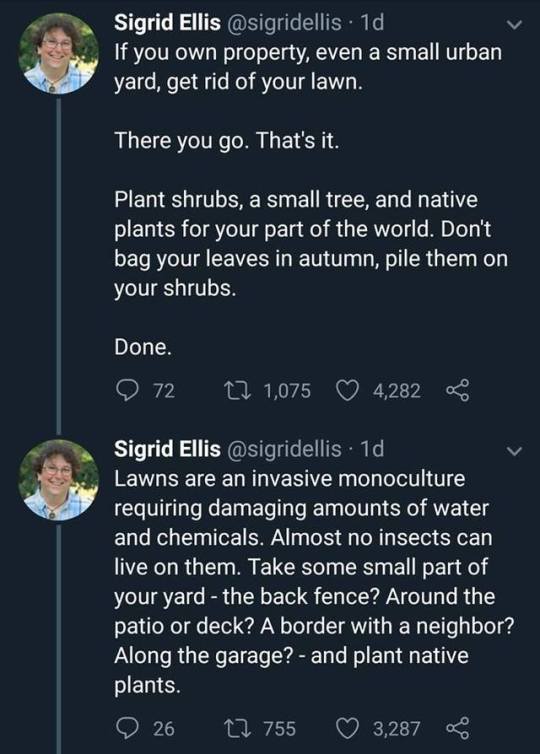Text
I started with succulents like everyone else but tbh orchids are rapidly becoming my plant blorbos. Everyone takes care of them wrong and it's not your FAULT because the care instructions that come with them are!! Incorrect!!! If you do what they say then your orchid will die!!!! If you give them the right environment they're SO easy. They're such easy plants to grow. They have been UNFAIRLY SLANDERED by a MISINFORMATION campaign. They don't deserve this.
37K notes
·
View notes
Photo
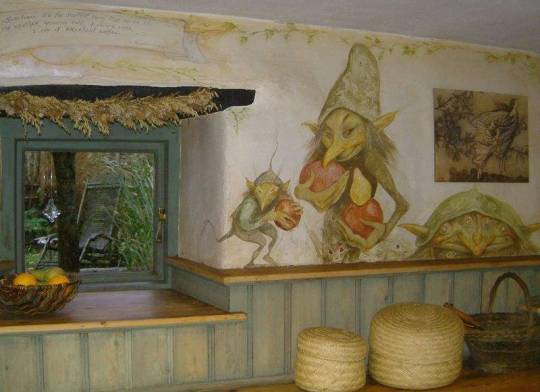
Terri Windling
Kitchen, Weaver’s Cottage
Wall Murals: Brian Froud “and others”
6K notes
·
View notes
Text
Why Artificial Intelligence and Natural History Don’t Mix
Originally posted on my website at https://rebeccalexa.com/why-artificial-intelligence-and-natural-history-dont-mix/
You may have seen recent articles outlining the dangers of foraging books “written” by artificial intelligence programs like ChatGPT, and then sold on Amazon. Maybe you even saw the warning I put out on social media, along with my guide on how to identify an AI-written book. I made it pretty clear that these foraging books are an absolutely terrible idea because there’s no control over where the program is hoovering up information and in what combinations it’s spitting it out. If the person putting in prompts has no experience with foraging and isn’t able to reliably check the work for accuracy, there’s a very good chance these books could have dangerous–even deadly–inaccurate information in them.

Click for larger version. Note the misspelled title on both the Amazon listing and the book cover itself. This is a common sign that a book has been written by AI.
The problem isn’t limited to books, or to foraging.
When I am looking for relevant links to add to my articles to give people further resources for reading or to support a point I am making, I sometimes run into websites that were clearly written by AI. Sites like Quora are even building ChatGPT right into their structure so that AI answers are at the top of the list. Google has started populating search results with blurbs from high-ranking websites–even if those websites are AI-written and feature incorrect information. If someone doesn’t take the time to click the link to see the website itself, they won’t be able to verify the information (and there are a lot of people who just take the search results at face value.)
I have seen ChatGPT and the like touted as “the next Wikipedia”, usually as a way to try to gain some legitimacy. This shows a complete misunderstanding of how Wikipedia works. Yes, each article is written by individual people, some of whom may be experts and others may be laypeople. But there are many editors double-checking the accuracy and quality of articles, and more importantly each person adding to an article has to cite sources and add them to the article’s references. This requires a person to be able to back up their claims with solid resources and have enough knowledge to gauge the quality of the references they’re using.
Here’s the problem: AI cannot fact check itself. Sure, it can regurgitate words commonly found together and make them somewhat coherent. But it cannot go through the process of critical thinking to discern whether a given source is of good quality or not, and it certainly can’t flag incorrect or even dangerous information. AI is sort of like the immortal monkey on the typewriter; even if you train it to read and guide its typing based on what it reads, it doesn’t have the capacity to consciously author a credible nonfiction text. In the unlikely event that it did manage to come up with a more or less accurate foraging book (with or without typos), it would have been entirely by chance. AI’s algorithms might train the monkey, but they can’t turn even the most diligent Ateles geoffroyi into Homo sapiens.

By KaterBegemot. CCA-SA_3.0.
More importantly, AI is incapable of experiential learning, something that is absolutely crucial to foraging in particular, and natural history in general. While people have varying levels of access to and engage with nature, natural history is perhaps one of the topics most antithetical to an artificial intelligence treatment. In order to learn deeply about nature, either you or the author whose work you are reading had to get out into the outdoors to explore some element of the world around them. Let’s imagine a child in Philadelphia who is obsessed with lions, but has a chronic illness that prevents them from even going to a zoo, let alone travel to Africa. They can still learn about lions from books that were written either by people who have worked with them directly, or who drew selectively from those firsthand sources with that critical eye AI lacks.
Foraging is an even more hands-on topic than large, social, carnivorous animals. You can read all the foraging books you want, but unless you have gone out into the field and examined various plants and fungi to determine species and then edibility, your knowledge is strictly theoretical. Sure, someone who has read every single book on foraging cover to cover is going to have a better understanding of the topic than someone who has read exactly zero books, but they have less real experience than someone who has gone out, found a single broadleaf plantain (Plantago major), identified it, and eaten it. And that newbie with their little plantain is more experienced than the most finely-tuned AI.
Because the nature of foraging requires you to get out and do something besides read if you’re really going to have a good understanding of the subject, it’s important that your source material also comes from people who have a good balance of theoretical and experiential knowledge. AI can never, ever provide that. Would it be a different story if the people throwing prompts into various AI programs acted as editors? Sure, assuming they had their own level of knowledge and experience to draw from–which they generally don’t. The best they do, gauging from the various fake “author” profiles on Amazon, is pick a bunch of popular topics in a wide range of fields, input some keywords, and expect to make bank on dozens of titles spit out in a period of a few weeks.

Click for larger version. Another hallmark of AI “authors” is that in spite of having no actual credentials they produce many titles in a very short period of time on a wide variety of often unrelated or only loosely related topics that an actual author would need a certain depth of experience to write on. (And yes, “Jason Cones” did “write” a book on foraging.)
This, of course, does not even start getting into ethical quandaries over AI and how these programs were trained on copyrighted material without the creators’ consent, nor that these books do not offer any references or credit for where their information came from. There are plenty of other folks who have gone into “AI as plagiarism software” territory, and there is a growing number of sites that will assess input text and determine whether it was written by AI or not. My bailiwick is primarily within the realm of AI’s impact on the safety of foraging, and I am quite happy to speak with media entities on this subject; just get in touch here.
Did you enjoy this post? Consider taking one of my online foraging and natural history classes or hiring me for a guided nature tour, checking out my other articles, or picking up a paperback or ebook I’ve written! You can even buy me a coffee here!
71 notes
·
View notes
Text
thinking about the person on the whatisthisplant subreddit yesterday who had never been able to grow anything successfully in a garden but last year their dog stole a whole acorn squash of their table to run outside and play with it like it was a ball and now they have acorn squash growing in their backyard. dispersal via dog toy shape
2K notes
·
View notes
Text
Mushroom Update
Just about ten days into their incubation, my spawn bags are showing signs of life!
My wine caps have a neat circular growth pattern right around the inoculation point.

My cordyceps are showing positive signs of growth. It’s subtler in the one bag but pretty obvious in the second.


Once the bags are fully colonized, the next step will be to grow the actual mushrooms. Since I have multiple bags of each, I’ll likely try two strategies for growth. I’ll grow half of them in the bags, and half of them in tubs, then compare the relative workload and results for each to hone in on a best way of producing these mushrooms.
13 notes
·
View notes
Photo
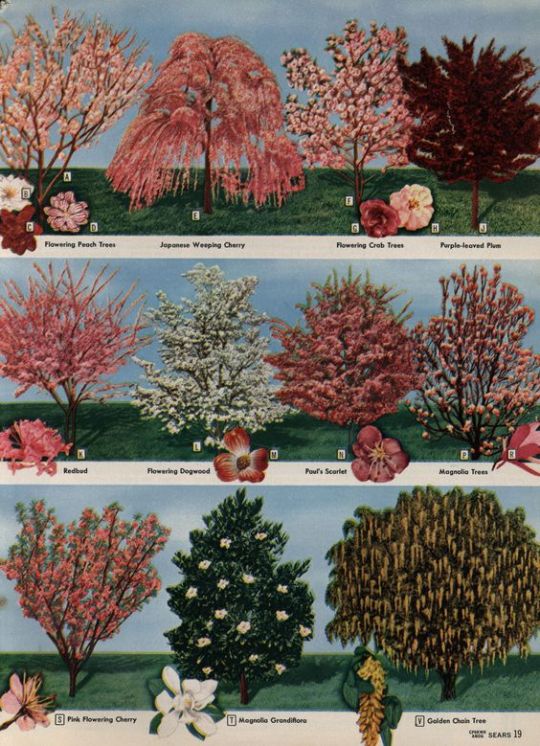
Flowering trees. Sears garden book: new for 1959. 1959.
4K notes
·
View notes
Text
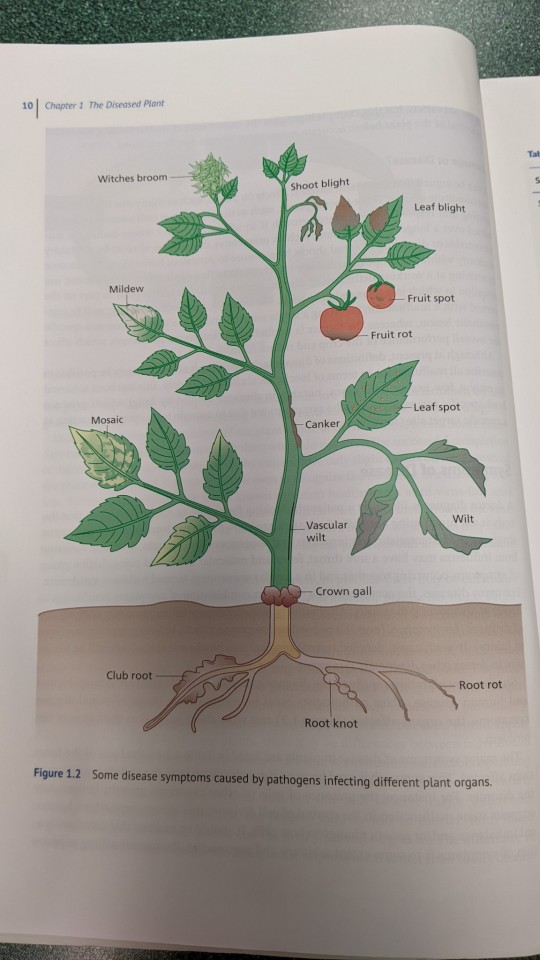
this is my son gunch who has every disease.. plaes help
10K notes
·
View notes
Text
The Permaculture Spiral Garden - A Great Starting Point
There is probably no other structure as popular for illustrating Permaculture in practice as the Herb Spiral. Okay, I guess I could mention the lasagna sheetmulching method or also the cob oven that tends to be the first hands-on project at a typical Permie intro session. But when it comes to showing how landscape design, zones and sectors, stacking functions, and efficient use of space and water come together in one unique structure, the Spiral Garden is unbeatable.

Turning Theory into Practice
In typical Permaculture Designer Certificate courses, but even in brief intro weekends to Permaculture, there tends to be a lot of theoretical discussions. Since the numerous design principles can be applied to any climatic region, from the tropical to the subarctic, and on any scale from the humongous to the tiny, the practical aspects of the ideas can easily get lost. That's where a good hands-on application comes, where the participants get to move around rocks and dirt, while realizing how much it ties in to the concepts they've just discussed. This way the apparent "main purpose" of "building something to grow all your kitchen herbs on", becomes a neat side feature.

Adjust Your Landscape!
The first thing to realize that landscape is welcome to be modified and adjusted to bring out the best in it. Clearly, while it is important to work with what's there already, it doesn't hurt think about mounds and valleys. And before you bring out the excavators for your large-scale farm, it makes sense to start small… say on a circle of 2-5 meters (6-16 feet) diameter. In other words, the Spiral Garden is a hill with a spiral shaped surface, leading down to ground level, or further down into a water hole. It can be made out of rocks, bricks, concrete debris, or anything else you have lying around that can hold your soil.

Design According to Your Scale
Looking around for existing Herb Spirals it's easy to get confused. Some are so big you can actually climb on them (that is, you have to in order to reach what's growing on top). Others are so tiny that you may not even want to step on them. The question is: which size is the right one for you? Since this is something you will have to decide almost daily in Permaculture, it doesn't hurt starting out with this important question.
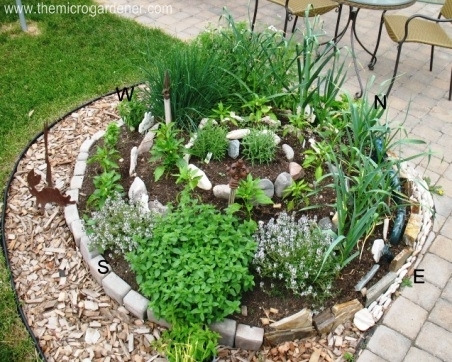
Organizing Your Spiral Garden
While there are seemingly endless types of Spiral Gardens, there are a few things they all have in common: They all start out with a region on the top, where water is bound to run off right away, leaving the soil relatively dry. This area is also the most exposed to the wind. Keep this in mind when choosing the plants that are going to live here. Ideally, the spiral should start sloping toward the East from here. Delicate plants that benefit greatly from the morning sun will appreciate this region. As the slope continues toward the South and West, it becomes more suitable for sun loving species. Finally, as the spiral reaches the ground level in the shady Northern part, it will be perfect for herbs that prefer less sun, more shade and more water, since the soil tends to be wetter here. (Note: This is for the Northern Hemisphere. In the Southern Hemisphere North and South are reversed.) To make full use of the runoff water, many people add a small pond at the base of the spiral, where additional aquatic plants, such as watercress, can be grown.

The given illustration offers a good number of herbs for a nicely diverse kitchen. Depending on what else you want in your Herb Spiral, you can add it in the most suitable region. Mint and lemon balm love the cooler, shady part with more water. Lemongrass is great in the sunny area, and tarragon and estragon prefer the dry top of the spiral. Of course, the idea is not limited to kitchen herbs. For maximalists, the same theory can work with a mountain you might want to terraform into a spiral farm. But right now I'd prefer to stay small scale.
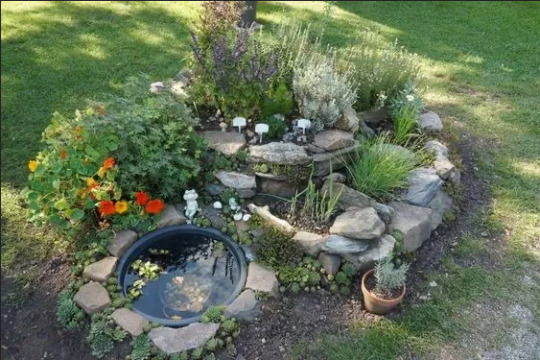
Plenty of Benefits (That's Why It's Permaculture)
As explained above, the main purpose of the Spiral Garden is not only to increase your gardening area by making use of the vertical, but also to create diverse climatic conditions, which do make a difference on the smallest scale. But as Permaculture tends to be, there are many other benefits to it. The structure itself offers great habitat for numerous animals, such as frogs, salamanders, lizards, but also pollinating insects, and of course others that may not directly benefit us, but by feeding on others they all add to the stability of our ecosystem. The structure itself will suppress weeds and make use of material that you're not likely to use elsewhere. Finally, depending on the size and location, it will be an ideal place to grow all your kitchen herbs right where you can access them most easily.

Some Things to Keep in Mind
When building the structure, make sure it will contain the soil in a nice trough, slanting slightly inward. That way bits and pieces that fall off will roll towards the center, until contained by the main mound.
Make sure the slope is always nice and gradual, avoiding sudden drops where the water can rush down quickly, eroding the soil.
If you're going to walk on your spiral, include a separate walkway that won't compress good soil. Most importantly, it should be sturdy enough to provide stability and make access safe.
Don't forget that while the structure is important to keep the soil in place, it is the soil that you'll be growing plants in. So it should have a good depth of 20-50 cm (8-20 inches) throughout the entire spiral. This can be the trickiest part!
Apply your own observation to which plants do better in which parts of the spiral. Also, with time you will find many other plants growing in it that you didn't plant. Before removing them, consider how much they actually bother your herbs, and whether their benefits may not outweigh their drawbacks.
Go Out and Build Your Own!
I hope this brief overview got you inspired to go out and try building an Herb Spiral yourself! I would love to hear your experiences with it!
Sources: 1, 2, 3, 4
3K notes
·
View notes
Photo

this book is worth more than a dozen restaurants that grow their own microgreens on the roof
222K notes
·
View notes
Text

American beaver
By: Unknown photographer
From: Disney's Worlds of Nature
1965
23 notes
·
View notes
Text
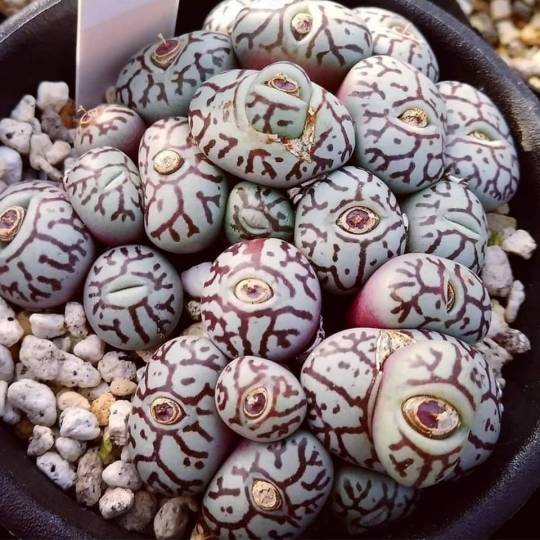
Conophytum Wittebergense is an uncommon succulent belonging to South Africa. It belongs to the Mesembryanthemum family and is known for its small, globular shape and unique, pebble-like look. The plant has little white or pink flowers that flower in the summer.
14K notes
·
View notes




